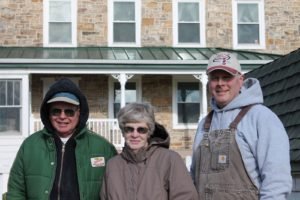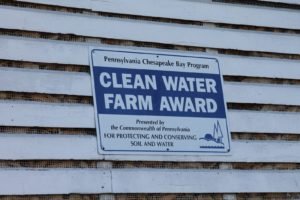AGRICULTURE ORAL HISTORY INTERVIEWS
NEVIN AND MARY ANN RICE
Conococheaque Rd
Jackson Township
Interviewed by Jane Hoover January 4, 2016
Nevin ( b. 1941) and Mary Ann ( b. 1942) are farming the land Nevin’s grandfather acquired in 1937. His grandfather moved to Blain from Oak Grove, near Landisburg, driving his small herd of cows along the road. Today the Rice’s own or rent about 500 acres on the land on the north side of Blain.
JANE: How did your farming operation become what it is today?
NEVIN: When this farm became available in 1928, my grandparents moved here and had their dairy of nine to eleven cows. My mother was big with horses. She could hitch the horses and work in the fields with horses. This would be 1928 to 1945. My dad had been married before, but his first wife had passed away in childbirth. But then dad found my mother and she was living here and he was living in Alinda, on a farm down there. Eventually he married my mother and moved onto the farm up here. My grandfather got gored with a bull and had to have his leg amputated, and he passed the farm over to my mother and dad.
When dad came he doubled the herd to about 21 cows. In 1955 or ’56, he added another addition to the barn and took it up to 35 cows, but then in 1957 he passed away. I still had two years in school and I was allowed to get to school late so I could get the work done. Helped my mother. My uncle was here, too. He was a big help.
I graduated in 1959 and I found my sweet heart here in school.
ANN: I still had a year to go.
JANE: So she was a local girl?
NEVIN: She was raised on a chicken farm west of Green Gates. She didn’t have any dairy, but she had a farm background. She’s a good, hard worker. I graduated in 1959; she graduated in 1960; got married in 19 61; had our son George in 1962.
Nevin, Ann and George
My mother kept milking up to 1980. Thirty-five cows seemed like a lot then. In 1980, I took over the farm. Mother stepped out, but that didn’t slow her down. She still did all the registration work and the breeding (artificial insemination), and the lawn mowing. She passed away in 1994 when she was 84. It was a big loss because I relied a lot on her.
In 1980, we built the milking parlor and did some more remodeling in the barn. We got room to house a little over 100 cows. Kept adding too, so we’ve got some old and we’ve got some new. For the most part it’s worked out well for us.
In 1975, I purchased another farm that adjoins right here across the road. Then I was renting ground, too. In 1988 we bought the Warren Barnes farm. It was 100 acres. Another farm became available in mid-1990’s and we bought that, the Hockenberry farm. I was farming another farm on shares and, when he passed away, I bought it. I rent some more ground beyond the Hockenberry farm. We’re a little over 500 tillable acres now. I know we’re not buying any more.
JANE: Do you let your cows out on pasture or do you keep them in a loafing shed?
NEVIN: They actually are both. From mid-November on they don’t get out much. Today’s the exception because the ground is frozen. We let some of the cows out for exercise. When it’s wet, we keep them in because we don’t like them tramping things up. In the summer, we try to have them out as much as possible. We actually have three groups: the low, the medium and the high. We alternate them. The low and the medium groups are in free stalls. They go out during the day. The high group are housed in the barn during the day and go out all night.
JANE: What do you mean, low, medium and high? Is that the amount of milk they produce?
NEVIN: Yes. As they come fresh they automatically go to the high group. The average for the high group is over 90 pounds of milk per day on 55 cows. As more and more cows come fresh, we have to look for someone to leave the high group. Have to balance it out. The medium group averages 65 to 70 pounds. Then the same thing happens again, and you move them down to the low group. averaging in the 50’s down to when we dry them off. Then they get a rest for two months.
The breeding age group are kept over at the main farm where we can watch them and get them bred at the right time. Calves all go to the calf hutches from the time they are born until about two months. Then they go over to the other farm where they are grouped again. About 10 years ago we built another large barn with manure pack housing where the older heifers go until they about one year. Then they are moved back to the free stall barn for breeding. When we get them bred and confirmed pregnant they go to other farms along with the dry cows. They are separated even though they are in the same facility. We make use of the barns in all the farms.
JANE: What’s a manure pack?
An inquisitive Holstein cow
NEVIN: It’s a big, covered area where they can move around. They get bedded on corn fodder, soybean stalks, or straw and we keep adding fresh bedding so it will stay dry.
We’ve added silos to accommodate the additional cows. We feed high moisture corn, in addition to the oats and barley, and soybeans for protein. We mix all our feed here on the farm, right down to the early calf feeding. George takes care of feeding the young stock and I do the milking herd.
We haven’t even talked about the steers. We keep the bull calves, have them castrated, and finish them off for beef at 1400-1500 pounds.
JANE: I didn’t realize that Holsteins made decent beef.
NEVIN: It’s good lean meat. They do well. We’ve been doing the beef for 30-40 years. I can remember ??? coming out here and getting his bull calves and taking them home in the car. We haul them to Carlisle livestock market or to Middleburg. Or to Green Castle. Over the winter, local people buy steers. We take them to a local butcher shop outside Blain and the buyer works with the butcher to cut up the beef.
I was fortunate to have a very good hired person who started in 1980 and worked for 25 years until he passed away. He worked until his very last. We’ve had different fellows, including my uncle until he passed away in 1998. I was really fortunate to have the help I’ve had. Now I have my nephew helping. We like two in the parlor. Ann did it by herself for years. One person can do it if you don’t have any sick or medicated cows. If they’re medicated, their milk has to be kept separate from the rest. It involves more time. Right now, there’s my son George and my nephew Wilfred in the parlor. Our daughter-in-law feeds the calves. We have a mother-daughter team who comes in to do the milking right now. The daughter is still in school, but the mother has farm experience. When they want off, Ann steps in to milk. So does my oldest grandson, when there isn’t too much homework.
It’s not like when I was in school. I very seldom had any homework. We had pigs and steers at this lower farm. Somehow it was arranged to feed the school cafeteria garbage to the pigs. That was my job. I drove a small tractor with a platform on the back and parked it near the exit from the cafeteria. Every day when I went out there were two cans of garbage sitting on the platform. I’d drive it home and dump it over the fence for the pigs. And when the ball field needed to be mowed, I disconnected the platform off the tractor, hitched up the school’s 5-gang mower and mowed the ball field, either during study hall or activity period. School was so close, I could just walk down through the cow pasture, jump the fence and I was there. Before I started school I would sit up on the hill and watch the kids out on the ball field playing.
JANE: Tell me about growing the crops to feed your cows.
NEVIN: Well, come spring, you just watch for the first nice days. The alfalfa’s got to get in and the oats have got to be planted at the very first opportunity you get. In your report card you get graded on good use of time .
I always got A’s there. You’re energetic. You just do it until it’s done.
JANE: What equipment and farming practices do you use?
NEVIN: The Farmall tractor we had when I was going to school was 40hp. That was a big tractor back then. In 1962, we thought we were getting a really big tractor when we moved up to a 560 Farmall, which is about 64hp. When I got out of school, my uncle and I would custom fill all the small silos from here out to the end of the valley. We kept wanting to get more done, so we kept upgrading. Our newest tractor now is a CVT Case 230 Puma which is a dreamboat. It’s 190 hp, but it can boost out more when it needs to. I don’t have GPS, though the tractor could handle it. I think I have 25 tractors. They are all exercised. I like to run one out to take me back a few years.
It’s all no till. We would never get done if we had to plow — picking stone and all that sort of stuff. Got a 15′ grain drill, a 10′ no till grain drill and a 10′ conventional drill that is nice to use to seed alfalfa. I can remember mowing hay with the same tractor I used to haul garbage from school. We used a 7′ sickle mower. Then the crimpers came; then hay binds that mowed and crimped in one machine. I got the first self-propelled hay bind in the county. That was a 12′ cut. Those were still the old sickle bar conventional mowers. We got a 10′ disk bind that mowed faster and cleaner. But I still wanted to mow hay faster, so I put a PTO and 3-point hitch on the front of one of the tractors. Now I can mow with one disk bind off the front and one off the back, so I can mow 20′ at a time. We’d never get the hay made if we didn’t use round bales, wrapped at high moisture. It seals them so they don’t mold inside. There’s very little waste compared to feeding a dry bale.
I feed the milking cows a high-moisture corn that’s stored in a Harvestor unit that’s oxygen limiting. Dry shell corn is 15% or less; the high moisture goes in at 18%-25%. No drying costs. The heifers eat ear corn, picked with my 2-row corn picker. Everything is planted with wider rows. If I switched to narrow rows, every piece of corn equipment on the farm would have to go. With my acreage and yields of 250 bu/acre on 38″ rows, I’m not excited to push for any more. I also sell it to Kreiger’s Mill in Loysville and he dries it if necessary. This year it was all under 20%. We put up over 1200 tons of corn silage in big silos. We’ve got some good custom operators who can help out.
For forage, I can remember as a little kid, dad had a corn binder that made shocks. Another tractor came along at the side with a wagon to catch the bundles. Back at the barn, we pulled the bundles off and put them into a ??? cutter to chop them and blow them up a pipe into the silo.
JANE: In what direction do you see farming going in the future?
NEVIN: Dairy herds have gotten larger, but I don’t know that our landbase can support extremely big herds. It’s too broken up. Trouts, Bowers, Martin’s, Kretzings have over 250 cows. For the bigger farms to raise enough food for their animals, they have to rent ground or buy more. One time if you had 55 cows you were a big herd, but now not.
The Amish started coming around early 1970’s. They’re not farming much anymore, but the Mennonites are. They came a little later. Many of the Amish have opened small businesses, bakeries, sawmills, recycling of vinyl siding, construction. Another thing that has started up with the Mennonites are the contract hog and poultry operations.
On one of my farms had a 12,000 bird layer house. It was owned by a corporation with seven of us involved in it. My contribution was to haul the manure. Someone else supplied the feed, another the chickens, another was the caretaker and another who took the eggs. When the caretaker retired, we couldn’t get a good caretaker, so we sold it to a neighbor who reconfigured the cages to hold 35,000 layers. Then later broilers. Then he lost the broiler contractor, so he took the sides off the building and put curtains up for turkeys. Then he wanted to get out of turkeys, so I bought it and now it’s a tractor shed.
The land will remain agricultural. I’ve already preserved four farms, the Barnes farm, the Hockenberry farm, the Smith farm and the Snyder farm. This little farm and the home farm are still to go.
The Rice family is honored for protecting and conserving our water



